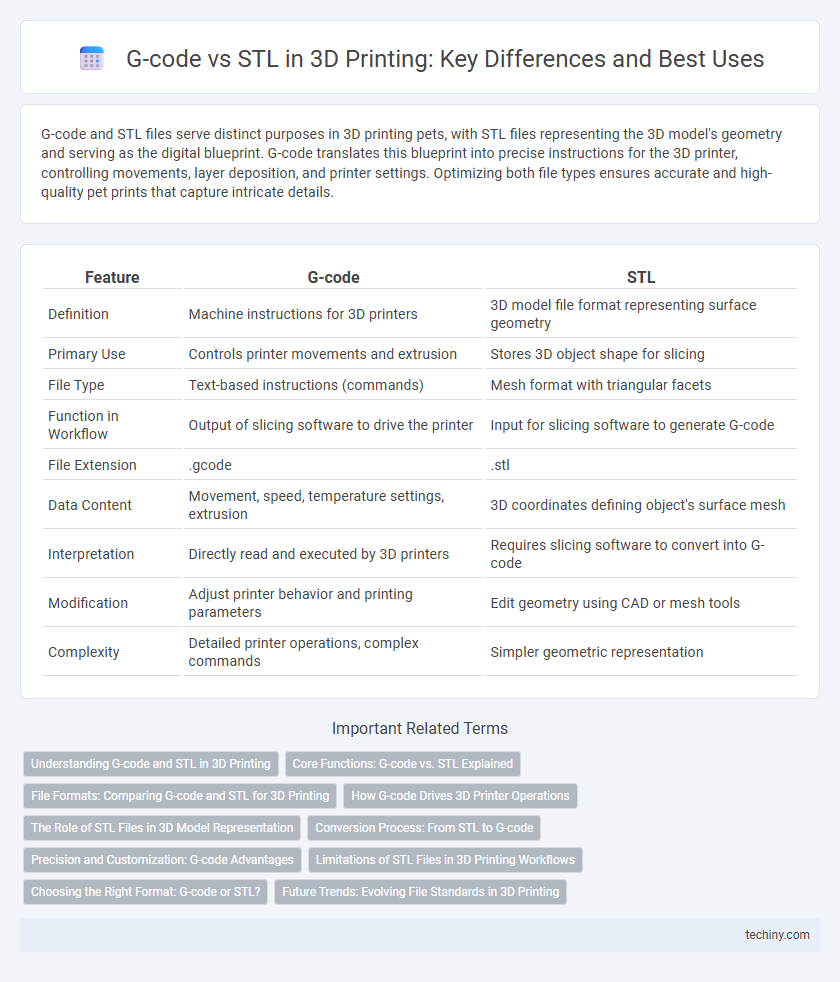G-code and STL files serve distinct purposes in 3D printing pets, with STL files representing the 3D model's geometry and serving as the digital blueprint. G-code translates this blueprint into precise instructions for the 3D printer, controlling movements, layer deposition, and printer settings. Optimizing both file types ensures accurate and high-quality pet prints that capture intricate details.
Table of Comparison
| Feature | G-code | STL |
|---|---|---|
| Definition | Machine instructions for 3D printers | 3D model file format representing surface geometry |
| Primary Use | Controls printer movements and extrusion | Stores 3D object shape for slicing |
| File Type | Text-based instructions (commands) | Mesh format with triangular facets |
| Function in Workflow | Output of slicing software to drive the printer | Input for slicing software to generate G-code |
| File Extension | .gcode | .stl |
| Data Content | Movement, speed, temperature settings, extrusion | 3D coordinates defining object's surface mesh |
| Interpretation | Directly read and executed by 3D printers | Requires slicing software to convert into G-code |
| Modification | Adjust printer behavior and printing parameters | Edit geometry using CAD or mesh tools |
| Complexity | Detailed printer operations, complex commands | Simpler geometric representation |
Understanding G-code and STL in 3D Printing
G-code is a machine language that directs 3D printers on how to move, extrude, and set temperatures to create objects layer by layer. STL (Stereolithography) files store 3D model geometry as a mesh of triangles, providing the digital blueprint used by slicing software to generate corresponding G-code. Understanding the conversion from STL to G-code is essential for precise control over print quality, speed, and material usage in 3D printing workflows.
Core Functions: G-code vs. STL Explained
G-code serves as the machine language that directs 3D printers on precise movements, extruder temperature, and speed, acting as the operational blueprint. STL files represent the 3D model's geometry in a mesh of triangles, providing a static digital shape without printer instructions. The core difference lies in STL's role as a design file versus G-code's function as executable printer commands essential for transforming digital models into physical objects.
File Formats: Comparing G-code and STL for 3D Printing
STL files store 3D model geometry in a mesh of triangles, serving as the primary format for design transfer and slicing preparation. G-code files contain detailed machine instructions, guiding the 3D printer's movements, temperature settings, and extrusion parameters during printing. Understanding the roles of STL as a design file and G-code as a printer command file is crucial for efficient 3D printing workflow and accuracy.
How G-code Drives 3D Printer Operations
G-code serves as the crucial instruction language that directly controls 3D printer hardware movements, temperature settings, and extrusion rates, translating design files into precise manufacturing actions. Unlike STL files, which represent 3D model geometry without operational details, G-code specifies layer-by-layer commands to guide printing paths, speeds, and toolhead behavior. This detailed control ensures accurate, high-quality prints by synchronizing mechanical functions with the desired object structure.
The Role of STL Files in 3D Model Representation
STL files serve as the fundamental format for 3D model representation, encoding the geometry of objects through a mesh of triangles that capture surface contours with precision. Unlike G-code, which provides machine instructions for printing, STL files focus exclusively on the spatial data necessary to visualize and prepare models for slicing. This separation ensures STL files maintain a platform-independent standard for exchanging and manipulating 3D designs before conversion into executable printer commands.
Conversion Process: From STL to G-code
The conversion process from STL to G-code involves slicing the 3D model into precise layers that the printer can interpret for accurate fabrication. Specialized slicing software analyzes the STL file's geometry and generates corresponding G-code instructions for nozzle movement, temperature control, and print speed. This translation is crucial for transforming the static 3D design into executable commands, ensuring precise layer deposition and high-quality 3D prints.
Precision and Customization: G-code Advantages
G-code offers superior precision in 3D printing by controlling the exact movements and extrusion rates of the printer's hardware, enabling highly detailed and accurate prints. Unlike STL files that only define the object's geometry, G-code translates design data into specific instructions for layer-by-layer fabrication, allowing customized print parameters such as speed, temperature, and infill density. This granular control optimizes print quality and material usage, making G-code essential for advanced customization and precision in additive manufacturing.
Limitations of STL Files in 3D Printing Workflows
STL files, commonly used in 3D printing workflows, are limited by their lack of support for color, texture, and material properties, which restricts the level of detail and realism in printed models. Unlike G-code, STL files only represent the surface geometry of a 3D object as triangles, without including instructions for printer actions such as layer height or print speed. These limitations necessitate additional processing to convert STL data into G-code, which directly controls the 3D printer's operations.
Choosing the Right Format: G-code or STL?
Selecting the appropriate file format between G-code and STL depends on the stage of the 3D printing process and the user's role. STL files provide a detailed 3D model representation, ideal for designers and slicing software, while G-code contains machine-specific instructions directly used by the 3D printer for precise movements and extrusion commands. Understanding the distinction ensures efficient workflow, with STL as the universal design format and G-code as the executable printing code tailored to specific printer configurations.
Future Trends: Evolving File Standards in 3D Printing
Future trends in 3D printing emphasize the evolution of file standards beyond traditional G-code and STL formats, aiming for enhanced interoperability and precision. Emerging formats like 3MF and AMF incorporate richer metadata and support for color, materials, and complex geometries, improving print accuracy and post-processing. Integration of AI-driven slicing algorithms will further optimize these file standards, reducing print time and material waste while enabling adaptive manufacturing.
G-code vs STL Infographic

 techiny.com
techiny.com